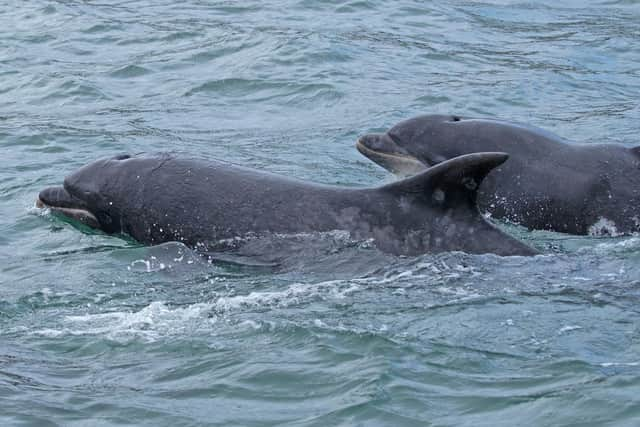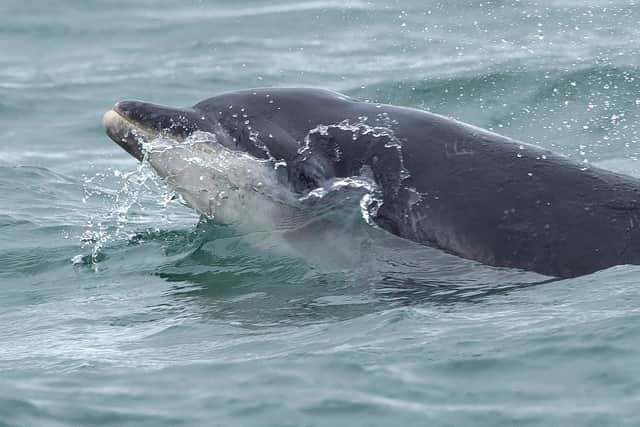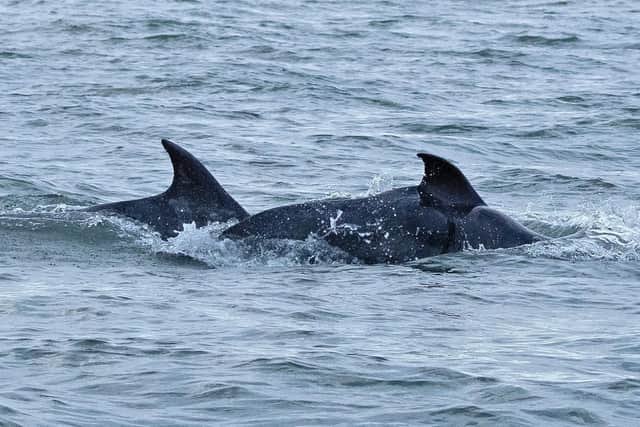The Moray Firth dolphins are back on the Yorkshire coast
There were several recorded sightings of the group last summer, when they were believed to have reached as far south as Spurn Point, and were also seen near Bridlington Bay and the feeding grounds off Flamborough Head.
Now the pod - from a group that normally live in the Moray Firth near Inverness - have returned to Yorkshire and have been filmed near Marine Drive in Scarborough.
Advertisement
Hide AdAdvertisement
Hide AdThey included a mother and calf, with the adult female having been known to observation groups based at St Andrews in Scotland since 2003.


The Scottish pod's behaviour has fascinated marine biologists in the past two years, and a decade ago sightings of the species were almost unknown in the area.
The University of Aberdeen confirmed that the April 2019 sightings in Bridlington Bay were the furthest south animals from the group have ever been recorded.
There are over 130 bottlenose dolphins living in the Moray Firth, and they are the world's most northerly population. They are bigger and fatter than their counterparts elsewhere in the world and have evolved to insulate themselves from the cold North Sea temperatures.
Advertisement
Hide AdAdvertisement
Hide AdThey follow shoals of fish such as mackerel and herring, but the reason for their sudden relocation to Yorkshire is otherwise a mystery and scientists are undertaking a major study to find out more about them.


This year sightings began in January and February in areas such as Withernsea and Hornsea, despite volunteer observers being stood down by the Yorkshire Wildlife Trust and Sea Watch Foundation during the lockdown period.
The Yorkshire Wildlife Trust's marine advocacy officer Bex Lynam said that although there would be a gap in the data collected while volunteer activity was forbidden, casual sightings by residents of coastal communities were still being reported.
"They have been seen lots of times this spring, especially in Hornsea and Withernsea. We haven't had many positive IDs because most of the people who have seen them don't have camera equipment that is advanced enough to take clear photos, so we can't say conclusively that they are from Scotland, but we think it is highly likely that they are from the same group.
Advertisement
Hide AdAdvertisement
Hide Ad"It is wonderful to see how far they travel, and although there are more sightings in later summer than in spring, we don't know whether that is because there are more eyes looking out for them or actually more dolphins."


The monitoring group now believe that the dolphins' presence in Yorkshire is year-round rather than seasonal.
"There have been a lot of sightings from residents rather than volunteers, and they seem to have been using this area more through spring. We think their presence is year-round now, although it peaks in summer.
"Bottlenose dolphins are opportunistic feeders and they are often seen at Flamborough Head, where there is a front where cold water from the north meets warmer water from the south. The conditions are nutrient-rich and there is plenty of plankton, fish and seals, which encourages dolphins and whales. They support the seabird colony as well."
Advertisement
Hide AdAdvertisement
Hide AdThe reasons for the pod leaving Moray Firth are also being explored.
"Marine life is generally under pressure from climate change and disturbance, but we can't say for sure that that is why they are on the move. Our project will build up a picture of their movements. They are a relatively new phenomenon on the Yorkshire coast - five or 10 years ago they were rare, now they are more commonly seen and in time we will understand why.
"We can't do surveys during the lockdown, so our work has been delayed and impacted - there will be a lack of data for this spring as there has been a two-month gap in collection."
The Yorkshire Wildlife Trust was also forced to cancel an education course organised for the captains of charter boats who run wildlife watching and fishing trips.
Advertisement
Hide AdAdvertisement
Hide Ad"We had a lot of interest, but I would like to see more skippers getting involved when it is rescheduled. The course is for all sea users - we have had issues with jet skiers in the past and it is about giving wildlife space and preventing disturbances.
"We are very lucky to have them."
Comment Guidelines
National World encourages reader discussion on our stories. User feedback, insights and back-and-forth exchanges add a rich layer of context to reporting. Please review our Community Guidelines before commenting.